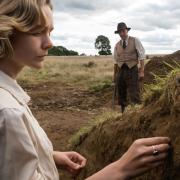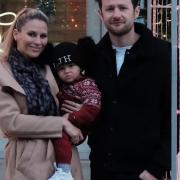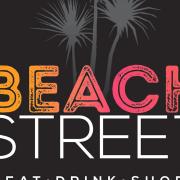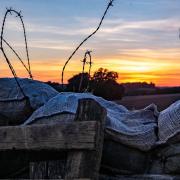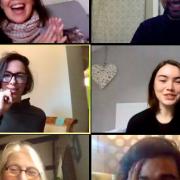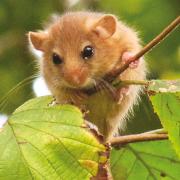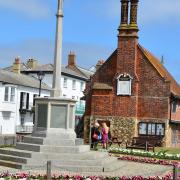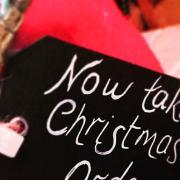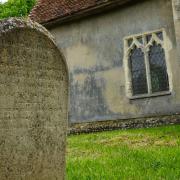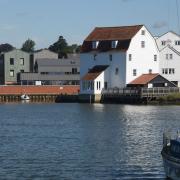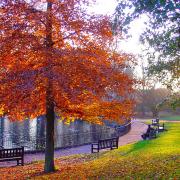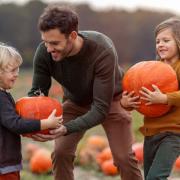Sharks’ teeth, ammonites and the remains of Ice Age mammals are just some of the great fossils you can find on the Suffolk coast from Bawdsey to Pakefield. Nature writer Matt Gaw goes hunting.

It sits, a rounded thimble, on a wave-cut terrace of shingle. A spineless pin-cushion of arsenic green, purple and goose-pimpled white. Not more than a centimetre across, it seems miraculous that this urchin is here at all, that it hasn’t been turned to dust by the roll of stone and wave. I pick it up and place it on the end of my little finger so it looks like a brittle, beautiful crown.
Further down the beach I can see my children, Seth and Eliza, scouring the tide-line for anything interesting. The dog shuttles excitedly between them and the sea, barking at waves and a few blackheaded gulls that drift about in a sodden, papier-mache sky.
I pocket the urchin and keep going, my eyes returning to the shingle, running over liquorice coloured bladder wrack and clumps of sea lettuce with the texture of week-old, bottom-of-the-bag salad. We’ve come to Bawdsey to look for fossils.
Previously, I’ve been lucky enough to find a palmful of needle-sharp shark teeth washed free from London Clay. Although the spot where I found them is today under a still rising tide, I’m hopeful of finding other relics from the Eocene, a time when Europe and America drifted apart and what would become the UK had a stable, tropical climate. This part of Suffolk’s coastline is well-known for its amber, the fossilised remains of resin that has oozed and dripped from trees some 40 million years ago. To hold a piece is to hold another world.
I walk slowly, every footstep creating a wave-suck sound of slipping shingle. I stoop to pick up dull, brown stones, testing their weight, wondering if a bit of spit and polish would reveal an amber lustre. In among the shell shards, shingle and grit there are other, less welcome finds.
Here, where the strata of land unravels into the sea, signs of the Anthropocene, the age of man, are easy to see. Feathers, gummed with oil, stick like arrows from coils of rope, while a strange blob of wax, probably ejected from a tanker’s belly, glues together stones and seaweed. I start to pick up these things too. Stones, wood and sea creatures are joined by the black heart of a battery core, bottle tops, rubber and glass.
We stop to drink hot chocolate and share what we have found. The children take it in turns to hold the urchin, tracing its shape with the tips of their fingers, tapping it, sniffing it. From their own pockets they produce their treasures – crab claws, wave-worked wood, hornwrack, countless shells, rice-crispy balls of whelk eggs, a stone that will fit warm inside your hand.
Seth has focused his search on mermaid’s purses and produces fistfuls from inside his coat. I recognise the larger, black, stag-headed pouch of the spotted ray and the delicate, dark green case of the small spotted catshark.
I wind its long, crimped tendrils around Eliza’s gloved finger and explain how the catshark lays its eggs in pairs, carefully fastening them to seaweed to make sure her embryos will not be cast adrift by the currents of the North Sea. Seth pulls a final, dried purse from his pocket and points at the thin slit where a young ray would once have slipped through.
I look at the children, their faces reddened with wind and salt, and think how I’m dreading the day when they decide it’s time to hatch into the world, to cut the tendrils that for now hold them fast. u
It sits, a rounded thimble, on a wave-cut terrace of shingle. A spineless pin-cushion of arsenic green, purple and goose-pimpled white. Not more than a centimetre across, it seems miraculous that this urchin is here at all, that it hasn’t been turned to dust by the roll of stone and wave. I pick it up and place it on the end of my little finger so it looks like a brittle, beautiful crown.
Further down the beach I can see my children, Seth and Eliza, scouring the tide-line for anything interesting. The dog shuttles excitedly between them and the sea, barking at waves and a few blackheaded gulls that drift about in a sodden, papier-mache sky.
I pocket the urchin and keep going, my eyes returning to the shingle, running over liquorice coloured bladder wrack and clumps of sea lettuce with the texture of week-old, bottom-of-the-bag salad. We’ve come to Bawdsey to look for fossils.
Previously, I’ve been lucky enough to find a palmful of needle-sharp shark teeth washed free from London Clay. Although the spot where I found them is today under a still rising tide, I’m hopeful of finding other relics from the Eocene, a time when Europe and America drifted apart and what would become the UK had a stable, tropical climate. This part of Suffolk’s coastline is well-known for its amber, the fossilised remains of resin that has oozed and dripped from trees some 40 million years ago. To hold a piece is to hold another world.
I walk slowly, every footstep creating a wave-suck sound of slipping shingle. I stoop to pick up dull, brown stones, testing their weight, wondering if a bit of spit and polish would reveal an amber lustre. In among the shell shards, shingle and grit there are other, less welcome finds.
Here, where the strata of land unravels into the sea, signs of the Anthropocene, the age of man, are easy to see. Feathers, gummed with oil, stick like arrows from coils of rope, while a strange blob of wax, probably ejected from a tanker’s belly, glues together stones and seaweed. I start to pick up these things too. Stones, wood and sea creatures are joined by the black heart of a battery core, bottle tops, rubber and glass.
Discover Kate Osborne’s favourite beachcombing spots in Suffolk
We stop to drink hot chocolate and share what we have found. The children take it in turns to hold the urchin, tracing its shape with the tips of their fingers, tapping it, sniffing it. From their own pockets they produce their treasures – crab claws, wave-worked wood, hornwrack, countless shells, rice-crispy balls of whelk eggs, a stone that will fit warm inside your hand.
Seth has focused his search on mermaid’s purses and produces fistfuls from inside his coat. I recognise the larger, black, stag-headed pouch of the spotted ray and the delicate, dark green case of the small spotted catshark.
I wind its long, crimped tendrils around Eliza’s gloved finger and explain how the catshark lays its eggs in pairs, carefully fastening them to seaweed to make sure her embryos will not be cast adrift by the currents of the North Sea. Seth pulls a final, dried purse from his pocket and points at the thin slit where a young ray would once have slipped through.
I look at the children, their faces reddened with wind and salt, and think how I’m dreading the day when they decide it’s time to hatch into the world, to cut the tendrils that for now hold them fast.





